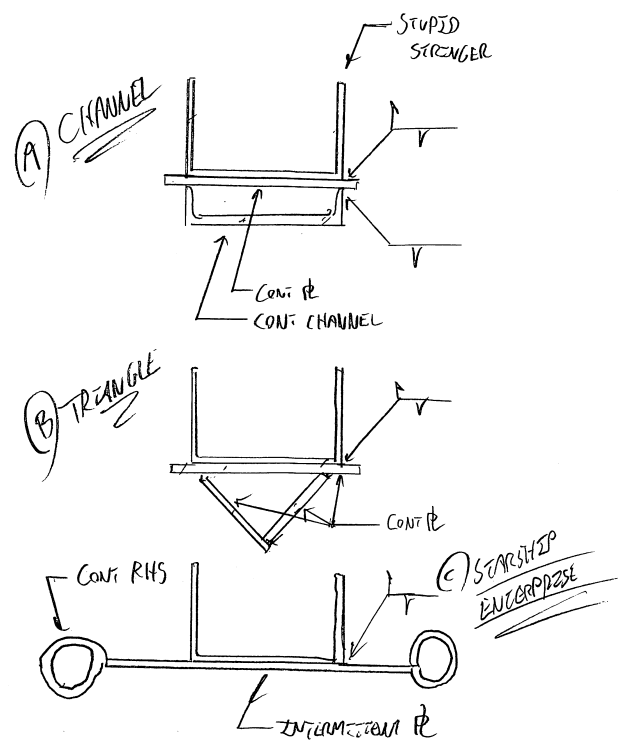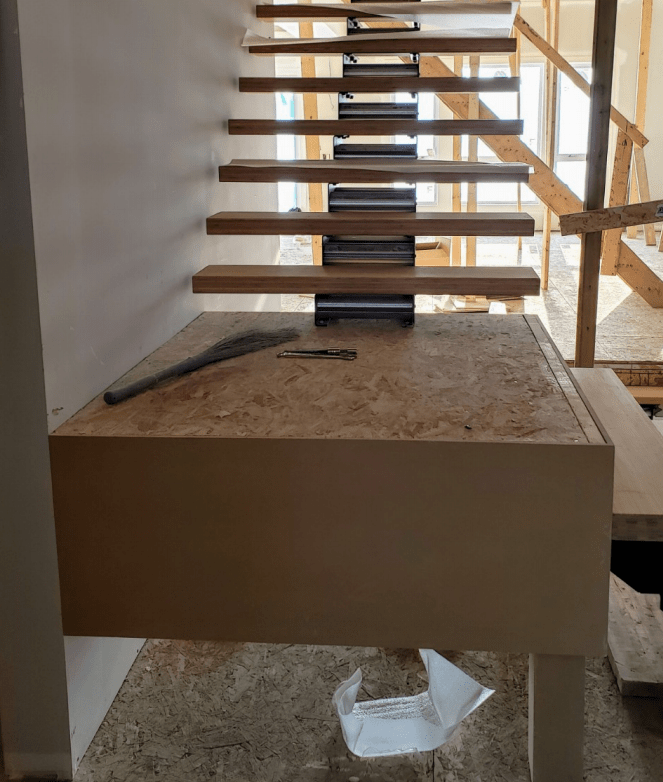1) I also live and practice in Alberta and have extensive experience with performance issues related to mono-stringer systems in wood framed homes. My wife is also a structural engineer who has made a specialty out of designing fancy homes for would be oil barons.
2) In all of the cases that I've seen, for which every one was a hollow tube stringer, the issue was indeed flexibility in the supporting structure. Unfortunately, the issue rarely has to do with the flexural stiffness of the supporting beams. So I'm not surprised that beefing those up didn't help much. The issue is really with the
torsional flexibility of the beams and, more critically, the torsional give in the connections. For these systems to perform well, you really do need a high degree of torsional rigidity at the ends. And, since wood is really just spun sugar, that's pretty tough to do. When it's done successfully, the answer is to spread out your fastener group significantly, to the tune of a couple of feet rather than a few inches. As Agent666 intimated, these stair systems simply are not well suited to wood structures.
3) Even at the low connection, I do not share your confidence. That concrete that probably seems very stout to you is likely just a 4" lightly reinforced slab on grade. Again, you want spread out fastener group and, based on the photos supplied, it doesn't appear that you have this. If anything, it looks like your fasteners are inside the stringer. That's not going to cut it.
4) I think that the proprietary stringer system that you've been sold is crap. A mono-stringer depends
utterly on it's torsional stiffness and the stringers that have been sold to you have next to none. Some of the flaws include:
a) As everyone has been mentioning here, what you need is a closed, tubular section so that you can utilize St.Venant torsional stiffness. Instead, Bocany has supplied you with an open section that relies on warping torsion and is therefore torsionally flexible.
b) With common members that rely on warping torsion, such as I-beams and channels, you at least have a continuous flange to improve the stiffness of the warping torsion mechanism. Here, because of the the way small channel sections are stacked, you don't even have
that.
c) If I understand the calculation package correctly, the channels segments aren't even welded together. Rather, they're flange
bolted together which will introduce all manner of additional flexibility that would be extremely difficult to account for.
The system is just terrible from a mechanical standpoint.
Terrible. In my mind, the very fact that an FEM report exists for this is evidence that these guys don't know what they're doing. A competent structural engineer develops a reasonable structural scheme and then uses FEM to validate and refine it. That, as opposed to starting off with a grossly flawed scheme and then hoping against hope that an orgy of 4th order differential equation solving somehow makes things right.
5) When I watch the videos, I see two things contributing to the movement. Firstly, there's the torsional flexibility resulting from the use of a crappy, open section. Secondly, I see torsional give in the connections leading to a sort of "slop takeup" phenomenon. You can reinforce this stringer easily enough but that's only going to take care of the first source of flexibility. There's not going to be much that you can do about the connection flexibility. For this reason, I don't recommend reinforcing the stringer. Rather, I think that you viable options are:
a) Throw your stringer away and attach your bamboo treads to a newly acquired 6"x8" HSS stringer with thoughtful connections. This would be oodles cheaper than the reinforcement anyhow.
b) Switch to a stair support scheme that abandons the use of the stringer in torsion. The ideas mentioned above that would accomplish this include: making stiff trusses of the guard rail system, attaching the treads to the walls where possible, and the business with restraining the treads vertically with wires. I'm afraid that your stringers and their connections are ill conceived junk and there's just not much getting around that. The do remind me of giant bicycle chains, however, which is admittedly cool looking.
6) Below I've shown some options for stringer reinforcement that might have legs. That said, as I mentioned above, I don't think that stringer reinforcement alone will solve your issues if the high and low stringer connections are not improved somehow.


